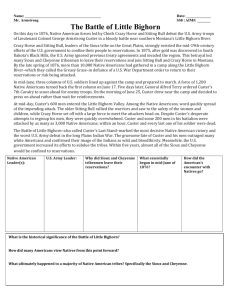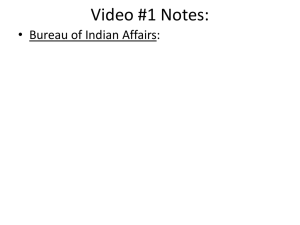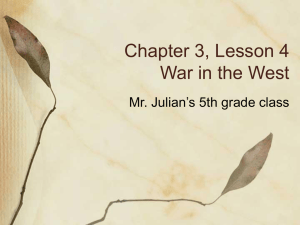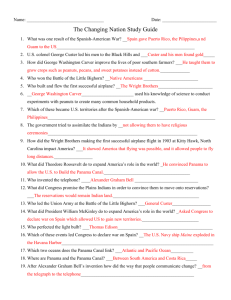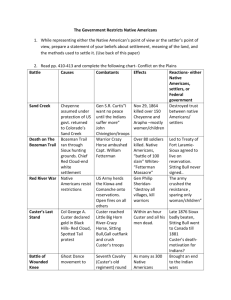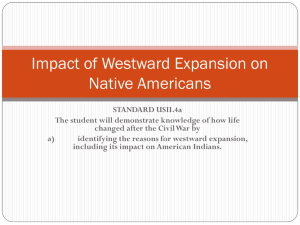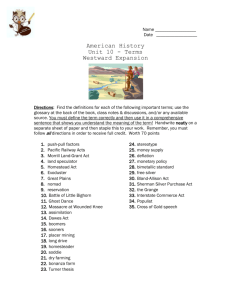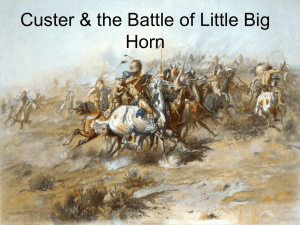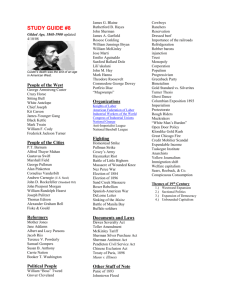Battle of Little Bighorn webquest
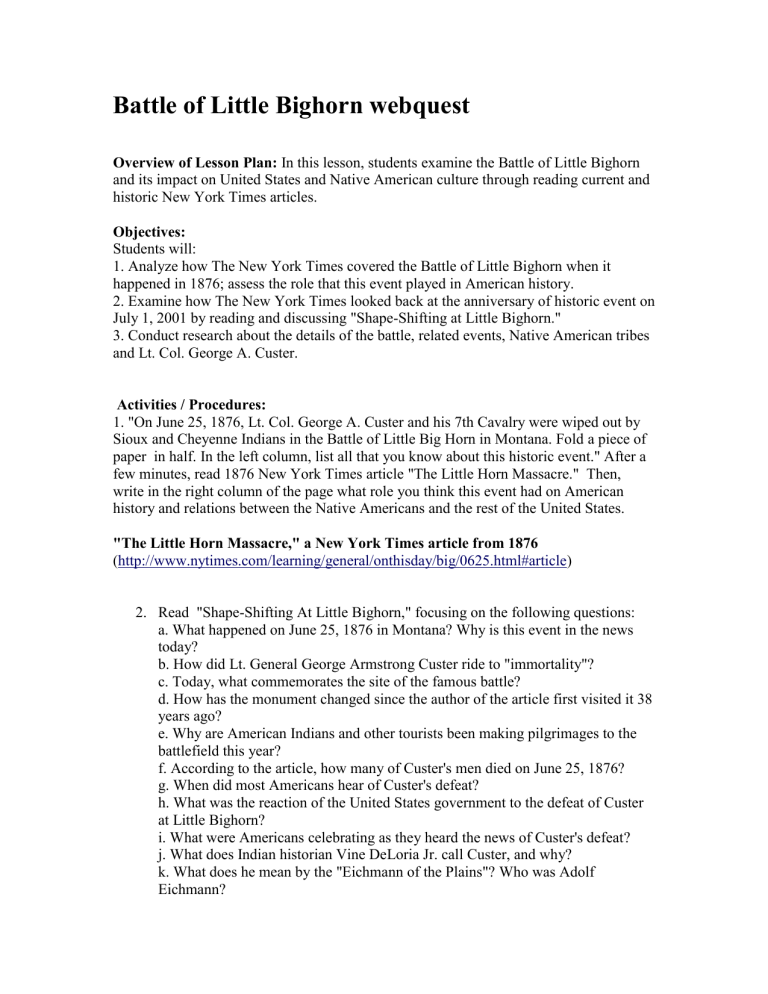
Battle of Little Bighorn webquest
Overview of Lesson Plan: In this lesson, students examine the Battle of Little Bighorn and its impact on United States and Native American culture through reading current and historic New York Times articles.
Objectives:
Students will:
1. Analyze how The New York Times covered the Battle of Little Bighorn when it happened in 1876; assess the role that this event played in American history.
2. Examine how The New York Times looked back at the anniversary of historic event on
July 1, 2001 by reading and discussing "Shape-Shifting at Little Bighorn."
3. Conduct research about the details of the battle, related events, Native American tribes and Lt. Col. George A. Custer.
Activities / Procedures:
1. "On June 25, 1876, Lt. Col. George A. Custer and his 7th Cavalry were wiped out by
Sioux and Cheyenne Indians in the Battle of Little Big Horn in Montana. Fold a piece of paper in half. In the left column, list all that you know about this historic event." After a few minutes, read 1876 New York Times article "The Little Horn Massacre." Then, write in the right column of the page what role you think this event had on American history and relations between the Native Americans and the rest of the United States.
"The Little Horn Massacre," a New York Times article from 1876
( http://www.nytimes.com/learning/general/onthisday/big/0625.html#article )
2.
Read "Shape-Shifting At Little Bighorn," focusing on the following questions: a. What happened on June 25, 1876 in Montana? Why is this event in the news today? b. How did Lt. General George Armstrong Custer ride to "immortality"? c. Today, what commemorates the site of the famous battle? d. How has the monument changed since the author of the article first visited it 38 years ago? e. Why are American Indians and other tourists been making pilgrimages to the battlefield this year? f. According to the article, how many of Custer's men died on June 25, 1876? g. When did most Americans hear of Custer's defeat? h. What was the reaction of the United States government to the defeat of Custer at Little Bighorn? i. What were Americans celebrating as they heard the news of Custer's defeat? j. What does Indian historian Vine DeLoria Jr. call Custer, and why? k. What does he mean by the "Eichmann of the Plains"? Who was Adolf
Eichmann?
l. How has the Battle of Little Bighorn continued to strain relations between
Indian tribes (the Lakota and the Crow)? m. How does Robert M. Utley, a Custer historian, characterize the tourism of
Little Bighorn National Monument? n. Why does he believe the federal government was "on the wrong track" when it built the visitor's center on the battlefield? o. Where might the new visitor's center be built? p. What does the most recent census say about the American Indian population in the Plains states? q. Why is the Battle of Little Bighorn still so controversial?
“Shape Shifting at Little Bighorn” http://www.nytimes.com/learning/teachers/featured_articles/20010702monday.html
Further Questions for Discussion:
--Why do you think that the Battle of Little Bighorn still stirs emotional responses 125 years later?
--Do you believe that life-costing victories in war should be celebrated? Why or why not?
--Why do you think the federal government changed the name of the monument from the
Custer Battlefield to the Little Bighorn Battlefield?
--How have American attitudes toward General Custer changed in the 125 years since his
"Last Stand"? Can you think of other figures in American history that have traveled along similar paths? If so, who?
Nez Perce webquest
http://www.indians.org/welker/joseph.htm
http://www.nezperce.com/npphoto1.html
http://www.nezperce.com/npeindex.html
Activity: Draw a picture based on what you’ve learned a bout Chief Joseph and the Nez
Perce. Use a piece of computer paper.
Other Information on the Web
Little Bighorn Battlefield National Monument ( http://www.nps.gov/libi/ ) is the national park's web site
Documents on American Indian Wars
( http://www.hillsdale.edu/academics/history/Documents/War/19Ind.htm
) includes firsthand letters from the Seminole Wars and from conflicts in the Northwest and West, including the Battle of Little Bighorn.
The Battle of the Little Bighorn, 1876 ( http://www.ibiscom.com/custer.htm
) from
EyeWitness explores the historic battle.
General George Armstrong Custer
( http://www.geocities.com/CollegePark/Classroom/1101/index.html
) provides information and links on General Custer, battlefield photos and more.
Resources
http://www.garryowen.com/ http://lbha.org/ http://leav-www.army.mil/history/custer.htm
http://www.historyguy.com/custer.html
http://www.civilwarhome.com/custerbi.htm
http://www.geocities.com/Athens/6979/bighorn.html
